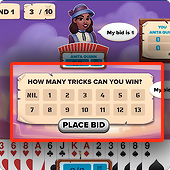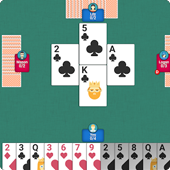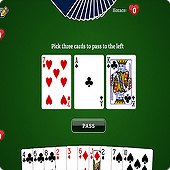Spades is a popular card game from the Whist family. Like other Whist games, such as bridge or hearts, the main objective of this game is to win as many tricks as possible.
The rules for spades are simple. You can learn the basics as you play the game. However, scoring spades may take you a couple of games to fully understand.
The good news is that we’re here to help. In our spades game guide, we show you how to play spades, how to score your games, and some strategies you can use to get the upper hand over the other players.
Are you ready? Let’s get started!
How to Play Spades
We are going to explain in detail how to play the spades card game. Before we do that, we want to give you an overview of the game.
Here is what you need to know.
- Spades is played with one deck of cards and four players. You will want to use two decks for games with more than four players.
- A game of spades starts with the dealer dividing the deck up between all the players. Each person in a four-player game will get 13 cards.
- Each person will play one card per turn, so a standard game of spades will have 13 turns or “tricks.”
- You will earn points for every trick you win. It is also possible to lose points.
- The objective of spades is to reach a specific point total (usually 200-500 points) before the other players or team(s).
That is an overview of spades. But there are a lot of nuances you need to know about. So, we’re going to get into the specifics now, looking the three phases of the game – the deal, bidding, and gameplay.
Our game guide will focus on playing spades individually. However, you can also play spades in a team format. Luckily, there aren’t too many differences between playing individually and playing as a team.
We explain the differences that do occur when you play individually and when you play as a team as those situations come up.
Let’s get started!
The Deal
How do you start a game of spades? Spades starts with determining who the dealer is. The first dealer is determined by drawing cards.
Each player will draw a card from the deck. The player with the highest-valued card will start out as the dealer.
From there, the rotation moves clockwise on each new hand. The dealer shuffles the deck and then the players can cut the deck if they wish to.
Each participating player is then dealt one card at a time until there are no more cards to deal. In a standard four-player game, this would mean that each player gets 13 cards.
The Bidding
After the cards are dealt, players will look at their cards and bid on how many tricks they will win during the upcoming round.
For instance, if a player believes that six of their thirteen cards will win them tricks, then they’ll bid six.
Bidding starts with the player to the left of the dealer and moves in a clockwise fashion. Players can also make a blind bid – a bid made without looking at their cards.
If you make a blind bid, you must hit that exact number during gameplay. You will receive a bonus if you do. We’ll explain how that works when we explain spades scoring in the next section.
If a player thinks they won’t have any winning tricks, they can make a bid of nil. If the player successfully wins no bids, they gain bonus points at the end of the hand.
When playing as a team, the number of bids made for each teammate are added up. That is the number of tricks that need to be scored for the team.
The Gameplay
Once each player has made their bids, the gameplay starts. Each trick round starts with the player to the left of the dealer laying down their card of choice face-up.
Play then moves in a clockwise fashion, with each player placing their card. The catch is that players must lay down a card of the same suit as the first player.
If a player doesn’t have a card of the same suit, they can lay down another card. However, they won’t win that trick. You can also lay down a trump card, which is any spades-suited card.
Spades-suited cards automatically trump any other suited card. The player with the highest-valued trump card wins that trick.
After all the players have laid down their cards, the person with the best card wins that trick. The player then must place the cards won from that trick in front of them.
That way, the other players can keep count of how many tricks each person has won. The player who won the last trick will start the next round.
Gameplay continues until all the cards have been used up. This marks the end of the first round. Points are scored based on how many tricks are won.
After the points are scored, the dealer in line starts the next round. Gameplay resumes until someone reaches the designated number of points needed to win.
How to Keep Score in Spades
Spades rules for scoring winning and losing tricks vary, but this is the most common approach we’ve seen.
You will get 10 points for each trick you bid on, plus an extra point for every additional trick you get beyond that. For example, if you bid five tricks and get six, you will earn 51 points.
However, you will lose 10 points for every trick you bid on for failing to reach your target. For example, if you bid on five tricks but only manage to get four, you’ll lose 50 points.
Underbidding and Bags
Underbidding – bidding on fewer tricks than you (can) hit – can be dangerous since you can make “bags” for every trick you get that exceeds your bid.
For every 10 bags you score, you are given a 100-point penalty. So, while you will get extra points in the short term, in the long run underbidding can significantly hurt your score.
What’s more is that bags carry over from one hand to the next. For example, if you get two bags on the first hand, five bags on the second, and three bags on the third, you will lose 100 points on the third hand.
Even though playing conservative can be a good idea at times, playing too conservative can lose you more points than overbidding.
Bid Nil and Bid Blind
Bidding nil and making blind bids is a high-risk strategy. Here is what spades rules say about scoring nil and blind bids.
- If you bid nil and you hit no tricks, then you win 100 points. If you win one trick or more, you lose 100 points.
- If you bid blind and you hit all the tricks you’re hoping for, then you also win 100 points. If you win less than what you bid, you lose 100 points.
- If you go over what you bid blind, you don’t lose any points. You don’t gain any extra points, either.
At the end of each round, points are added up and scored. These scores are then added to the scores from the previous round.
With this type of scoring, the first player (or team) to reach the predesignated point total wins, and the game is over.
Now you know the rules for how to play spades. What we want to do next is look at a couple of spades variants and then some strategy tips.
Spades Variations
While spades do have a set of rules to dictate how the game goes, the rules have been known to be bent a little.
For the most part, the spades game rules we abide by are a consensus rather than a formal way of play. The same standard usually goes for spades games offered at online sites and informal house games.
That said, spades variations do exist. Here are the most common variations of the game.
Joker Cards Trump All Spades
In spades, the spade suit is generally known as the trump card. Some alternatives might allow for a wild card, such as a joker.
This wild card trumps all other cards, including all spades. If incorporated, jokers are usually added to replace two of the deuce cards.
This doesn’t alter the gameplay too much. However, the holder of a wild card can rest easy knowing that they have a guaranteed trick in their hand.
Partnership Bidding
When playing as a team, some games allow for “partnership bidding.” This allows teammates to discuss what tricks they think they can win before the gameplay starts.
However, with this variation, opponents are also allowed to listen to what the other team has to say.
One tactic you must watch out for is the other team communicating in code so that you can’t understand what they’re saying.
Another interesting tactic is using partnership bidding to bluff out opponents. This can make opponents think that they have more tricks than they do.
Either way, if you do decide to incorporate partnership bidding within your game, make sure that all the players are clear on the rules before you proceed.
Scoring Variations in Spades
Not everyone plays with the same spades scoring rules as we do. For instance, some players might only award 5 points for each trick. Others might award 20 points.
But perhaps the most common area of variation is with overbidding. As we’ve already mentioned before, when someone overbids, they lose 10 points for each bid they made.
With other variations of spades, overbidding might bring different penalties.
A more laidback variation says that overbidding will result in 0 points for that round.
Another variation will have you lose points based on the difference between what you bid and what you scored.
For example, if you made seven bids but only scored five tricks, then you would lose twenty points.
Whichever variation you choose will add its own unique element to your game of spades.
However, just as with partnership bidding, make sure that all players agree on the spades variant being used before you start playing.
Spades Strategy for Individual Play
Spades is a great game to play when passing time. However, if you want to win, you’ll need to have some type of strategy. Strategy is key to garnering the maximum number of tricks each round.
So, once you learn how to play spades, it makes sense to start learning a few strategies.
A lot of the strategy for spades comes down to knowing which cards to bid on, what cards to play or hold, and when to take your chances.
Let’s look at some spades strategies you can incorporate into your playbook.
Know Which Cards to Bid On
Knowing which cards to bid on is probably the most important tip we can give you.
Since you can get penalized for over-bidding, you always want to make sure you know your chances for each card.
For instance, you always want to bid on an ace or king since these have the highest denominations of their suit.
Likewise, you want to be cautious when betting on number cards since these can always be trumped by a spade or a higher card of the same suit.
An example of this would be if you played a nine of hearts. This is a risky card to play (and start with) since there are several over cards your opponents can play to steal the trick from you.
Every trick you lose makes it that much tougher to meet your bids. This can cause you to lose points. So, take your bidding seriously.
Know When Not to Bid Nil
Bidding nil is a risky bet, but it can pay off if you manage to do it correctly. Most of the strategy for bidding nil in spades is knowing when to bid nil and when not to.
Generally, you should look at making a nil bid if you only have one or two cards in your hand that have a chance of winning a trick. Even then, it can be risky to make a nil bid.
We recommend making a nil bid only if most of your cards are numbered cards and you have no honor cards.
You shouldn’t make a nil bid if you have the following cards.
- 4 or more spades
- Ace or king of spades
- Solo honor card in any suit
For reference, a solo honor card is the ace, king, queen, and jack of any suit.
Bid Based on Position
One thing that Texas Hold’em and spades have in common is the importance of position. Whatever position you’re in for that round can play a big part in the number of bids you make.
For instance, if you’re the last player in the rotation, you can get away with playing more lower-valued spades since it’s less likely you’ll get trumped by a higher spade.
On the other hand, if you’re first in position, you’ll need to be more conservative with your bids since you don’t know exactly what the other players have.
We recommend playing more conservatively if you’re first or second in the rotation. However, if you’re closer to the last few players in the rotation, you can bid a little more freely.
That wraps it up for our spades strategies when you’re playing solo. Now let’s look at some spades strategy for team play.
Spades Strategies for Teams
Spades strategy for individual play transfers over when playing with a teammate. However, there are also other unique strategies you can use when playing as a team.
If you are planning on playing team spades, we recommend you take a look at some of the following strategies. They just might give you the upper hand.
Watch What Your Teammate Plays
When playing with a teammate, the last thing you want to do is trump them. This can lead to you overbidding since you’ll win less tricks if you’re both playing your best cards in the same round.
If you see that they need a certain suit to reach their bid level, provide that to them in order to satisfy your tricks.
If they’ve already reached their number of bids, then don’t give them suits that will force them to trump you with a spade.
Keep Team Bid in Mind Always
Playing as a team means focusing on two things; reaching your individual bid and reaching the team bid.
We recommend you always prioritize the team bid first.
Reaching your number of individual bids is important but reaching your number of team bids is crucial.
Reaching your number of team bids is what will help you score points and avoid penalties.
If you only focus on reaching your individual bid, chances are you’ll end up overbidding or underbidding as a team. This will result in a loss of points.
Always focus on working with your teammate to reach the number of team bids makes more sense than focusing on your individual bids.
Playing Spades Online
Good news, you can play spades online. But your options may be limited depending on whether you want to play spades for real money or for free.
Let’s start with your free options. Here are a few websites that offer free spades card games.
You will play against other people on most of these sites. The exception is CardGames.io – it looks like you play spades against a computer there.
These sites are a great way to play spades for free. You don’t even have to create an account to play. Just load up the site in your browser and you’re all set.
Free sites are also a risk-free way to learn how to play spades and hone your strategies for when you want to start playing spades for cash.
But what about when you’re ready to play spades with money? What are your options then?
Your options are limited. Several years ago, it was possible to find spades card games on many of the best gambling sites. But not today.
You’ll can still find spades at some of the top online casinos, just not all of them. Another option for real money spades is WorldWinner.com.
They have a game called Spades Showdown. It is a team-based game in which the team that reaches 250 points first wins.
Your score, the time it took you to complete the game, and other factors all contribute to your final score. Your final score is pitted against other human players who are also playing Spades Showdown.
The person with the highest score wins the tournament. If you paid to play Spades Showdown, you may receive a portion of the prize pool. It all depends on how well you do and the number of entries.
These aren’t high stakes games. You’re not going to strike it rich playing spades online. But if you want to play online spades for money, World Winner is a decent choice.
Other Ways to Bet on Spades
Since there aren’t set standards for betting on spades, you can choose to bet however you and the other players agree on.
There are a variety of different ways you can bet in spades. However, perhaps the most common version is to bet on a winner via a cash pool.
Betting on Who Wins at Spades
When betting on a winner, every player will put forward a set amount of money. This creates a cash pot which can be split among players based on what place they get.
Since spades usually only incorporates four players, most cash pots will only pay out the winner.
For instance, say there are four players playing. Each player puts in $10 to create a $40 cash pot. Whoever wins the game will take home the $40.
You can also do other variations. For example, first place could take home $30, and second place could get $10. This would allow the second-place player to win their money back.
Betting Before Each Round
Another approach you can take is to place your bets before each round.
You’d essentially be betting on whether you will be the person taking home the most points at the end of the round.
For instance, if there are four players playing, each player can put in a dollar before seeing their cards to create a $4 cash pot.
Once all thirteen cards have been played, the player with the most points take the $4. Then, another cash pot is created before the next round of cards is dealt.
Betting on Point Differentials
If you want to take another route, you can assign dollar values to each point. For instance, if you assign a one-dollar value to each point, then 10 points would be $10.
After the game has finished, the losers will pay the winners based on the point differential between the losers and the winners.
An example of this would be if you had 500 points and one of the players had 450 points. Therefore, they would owe you $50.
One caveat with this is that points can quickly add up. Thus, assigning a dollar for each point can lead to a high-stakes game where a lot of money is on the line.
 Top Tip
Top TipHow Should You Bet in Spades?
As we’ve already mentioned before, there aren’t set betting rules for spades. This means you can bet however you want.
You can combine different betting methods together. For instance, you can bet before each round and you can bet on an overall winner. You can also create a cash pot and do point differentials.
We recommend choosing a betting method that aligns with both you and those who are playing. After all, there is money on the line.
You’ll also want to make sure that if you are playing with money, you’re playing with amounts everyone is comfortable with.
Should You Play Spades?
You should consider playing spades if you’re looking for an easy, accessible card game to play with friends.
You can start up a game within minutes if you have a deck of cards and a few friends to play with.
And while it is a simple game, there’s plenty of spades strategy for you to learn in order to keep the game entertaining.
You’ll also learn mathematical concepts like probability, logic, and controlling risk.
These are all skills that can be transferred over to the real world, as well as other card games involving strategy, like blackjack and Texas Hold’em.
Even though spades isn’t a traditional gambling game, it’s easy to set up some betting rules with your friends to make a little money. You can also play spades for money online.
Thus, we recommend you play spades. And now that you know the rules for playing spades, all you need is a deck of cards, some friends, and you’ll be set to have endless fun!
Spades FAQ
- Should I Always Play the Highest of a Suit?
-
APlaying the highest of a suit can be beneficial. However, you shouldn’t ALWAYS play the highest card in a suit.
For example, if the highest card you have is a queen of hearts, someone could easily trump that with a king or ace of hearts. It might make more sense to wait until those cards are played before you play your queen.
- Can I Play Spades Online for Real Money?
-
AYes, you can play spades for money online. You won’t find it offered at all online gambling sites, though. One reputable site we know of that offers real money spades is WorldWinner.com.
- What is the Easiest Way to Play Spades for Cash with Friends?
-
AWe recommend assigning a dollar value to each point. The winner of the game will receive their winnings based on the point differentials multiplied by the dollar value.
- What is the Best Strategy for Playing Spades?
-
AOne of the best strategies for spades is to take tricks early. Furthermore, you only want to take tricks on the cards you bid on. Taking extra tricks could result in bags which can lower your score.
- Where Did Spades Come From? Who Invented It?
-
ASpades was created in the late 1930s by the Kirkwood family. However, it didn’t start to gain popularity until the 1940s when the Kirkwoods moved to New York in search of work.
The game’s rise in popularity was largely due to World War II. Soldiers would play spades as they traveled the globe, exposing more people to the game.
After the war and thanks to the GI Bill, veterans brought the game back home to US colleges where it spread even further within the United States. It didn’t hurt that the instructions for spades are easy to understand, either.
Games Similar to Spades
You’ll have plenty of fun playing spades with your friends. But what about spades alternatives? Are there other trick-taking games you can play instead?
Yes, there are. Here are a some games we recommend you check out next.
Euchre
Euchre is a trick-taking card game that utilizes a partial deck of cards rather than a full deck of cards.
Four players are required, and they’re paired up into two teams. The entire goal of the game is to be the first team to win 10 points.
In the game, there are attackers and defenders. Like spades, each player must follow the suit at hand within the rotation. The player with the highest card at the end wins the trick.
If the attackers win three or four tricks, then they win one point. If they take five tricks, they win two points.
If the defenders win three or four tricks, then they win two points. If they take five tricks, they win four points.
Like spades, euchre is all about winning the tricks in rotation. However, Euchre is more about teamwork with fewer points scored.
If you had no problems learning the basic rules for spades, then euchre will be a cinch to pick up.
Hearts
Hearts is yet another popular card game, but with its own twist. The purpose of this game is not to score tricks but rather to avoid them.
In a four-player game, 13 cards are distributed to each player. The goal of the game is to have the lowest score at the end.
Once a player reaches a designated score (usually 100), gameplay stops, and points are counted. The player with the lowest score is the one who wins.
Points are only given to cards with hearts on them. However, if you get the queen of spades, you are given 13 points.
Like spades, hearts is all about taking tricks. Taking tricks can be a bad thing, though, especially when the cards have a heart on them.
When comparing hearts and spades to one another, the gameplay is about the same. Players take turns placing down cards, and the player with the highest-valued card wins the trick.
The two games incorporate completely different strategies and concepts, however.
For instance, in spades, using high-value cards gives you a better shot at winning. In hearts, you want to try to get rid of your high-value cards as soon as possible.
Thus, while the gameplay is about the same for these two card games, how you play hearts is completely different from how you play spades.
 75%
75% 80%
80%








 Latest UFC 317 Odds for Topuria vs. Oliveira and More
Latest UFC 317 Odds for Topuria vs. Oliveira and More  RANKED: The Best and Worst US States for Gamers in 2025
RANKED: The Best and Worst US States for Gamers in 2025  Deciding if Casino Bonuses Are Worth it at Online Casinos
Deciding if Casino Bonuses Are Worth it at Online Casinos  UFC 316 Betting Guide with Latest Odds and Top Picks
UFC 316 Betting Guide with Latest Odds and Top Picks 